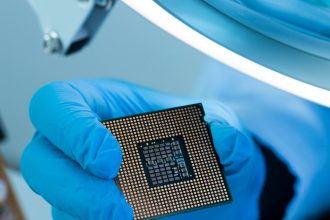Exploring the Future of Augmented Reality: How Ultra-Thin Displays Are Making AR More Accessible and Seamless Than Ever Before
Hey there! Have you ever wondered what the next evolution of tech might look like? Well, get ready, because augmented reality (AR) is heading into some seriously exciting territory — and it’s all thanks to ultra-thin, unobtrusive displays. Imagine this: you’re walking down your favorite street, and instead of lugging around bulky AR glasses or constantly tapping at your phone, the world around you seamlessly transforms — digital info floating in your line of sight, integrated effortlessly into your environment.
Sounds pretty futuristic, right? But this isn’t just sci-fi; it’s becoming a tangible reality. The secret lies in ultra-thin screens that are so lightweight and discreet, they can be embedded into everyday objects or even directly into your eyes. Think contact lenses, eyeglass frames, windows, or walls — all serving as invisible portals for digital content. This marks a significant shift from bulky hardware to almost invisible overlays, making AR truly a part of daily life rather than a niche gadgetry.
What’s truly remarkable here is the potential. For gamers, this could mean immersive experiences without the need for bulky headsets. For professionals, hands-free data displays could streamline workflows, especially in fields like medicine, manufacturing, or engineering. And for everyday users, it’s a future where digital information is available when you need it — popping up on your window or mirror, but otherwise staying out of sight. The goal? Making AR as natural and unobtrusive as looking through a clear window. No glasses required.
How do these ultra-thin displays work? Well, that’s where the magic of engineering, optics, and new materials comes into play. Let’s break it down in the next section.
Breaking Down the Tech: How Ultra-Thin, Glasses-Free Displays Are Changing the Game and What It Means for Daily Life
Alright, time to get a little geeky. How are ultra-thin, glasses-free AR displays actually made? And how will they affect our daily routines? Unlike traditional screens or bulky AR glasses, this new wave of tech isn’t just about making things smaller — it’s about rethinking how digital images are displayed and perceived.
At the core, many of these displays utilize cutting-edge technologies like micro-LEDs, OLEDs, and advanced optical waveguides. Let’s start with the basics:
Micro-LEDs and OLEDs
These are ultra-thin light-emitting materials. Micro-LEDs, in particular, are tiny LEDs that can produce bright, vivid images with high contrast while remaining incredibly thin and energy-efficient. OLEDs (Organic Light Emitting Diodes) are similarly flexible and thin, perfect for conforming to curved surfaces like contact lenses or flexible screens.
Optical Waveguides
This is where things get really clever. Waveguides are thin, transparent materials that manipulate light to direct images precisely into your eye or onto a surface. Think of them as mini optical highways, splitting and steering light through tiny channels, creating the illusion of digital overlays that appear seamlessly integrated into your environment.
How it Comes Together
Imagine a super-slim module embedded into a glass, lens, or surface — possibly just a few millimeters thick — projected with images that can be seen directly by your eye. Some approaches involve projecting images into your eye via tiny prisms or mirrors built into contact lenses or glasses frames, allowing digital info to “float” in your natural field of view.
The Dream of Contact Lens Displays
One of the most ambitious goals is integrating these displays into contact lenses. These lenses could project tiny, high-resolution images directly onto your retina, offering a truly unnoticed AR experience. While we’re still in research phases, some prototypes have already demonstrated basic functionality, hinting at a future where you could see digital notifications or directions without any hardware in your line of sight.
Challenges to Overcome
Of course, making this a reality isn’t without hurdles. Powering such tiny displays efficiently remains a big challenge — how do you keep them running all day without frequent recharging? Ensuring safety and comfort during prolonged use is another hurdle; these displays must be safe for sensitive eye tissue and lightweight enough to wear comfortably. Additionally, integrating cameras and sensors for spatial awareness, high resolution, bright display in sunlight, and keeping costs down are all active areas of development.
Everyday Impact
Once these technologies mature, imagine environments where your windows display real-time weather, your mirrors show your notifications, or your clothing acts as interactive interfaces — all without bulky gadgets. It’s about embedding digital seamlessly into the fabric of your world. The promise is a future where augmented reality becomes so integrated and discreet that you hardly notice it, yet it’s always ready to enhance your experience.
Wrapping Up: The Dawn of a New Interface Era
So, what does all this mean for you and me? Well, ultra-thin, glasses-free AR displays are poised to reshape how we interact with digital content, making it more natural, immersive, and integrated into our daily lives. Whether it’s through smart surfaces, contact lenses, or invisible overlays, the goal is to move from clunky hardware to invisible, elegant solutions.
While there are still hurdles to clear — from power management to safety standards — the progress is encouraging. We’re inching closer to a world where digital information flows seamlessly around us, just like air or sunlight. And the best part? You probably won’t even notice most of it happening.
So, the next time you walk down the street or look at your window, imagine a future where the real world and digital world coalesce effortlessly — all thanks to ultra-thin, glasses-free displays. It’s an exciting horizon, and we’re all in for some fascinating innovations ahead!







